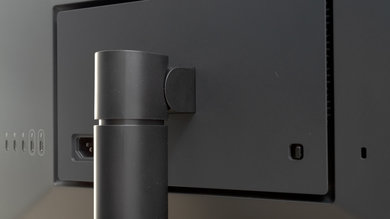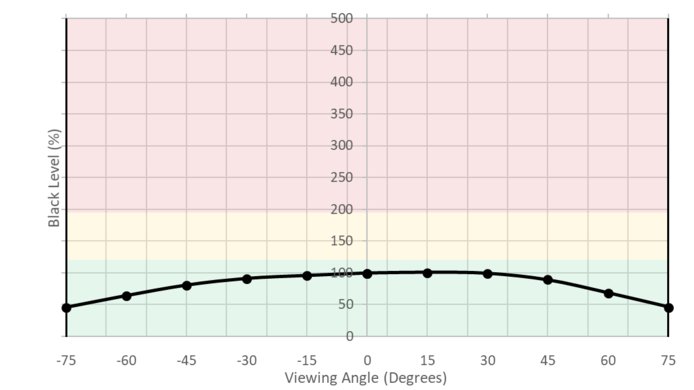The LG UltraFine 4k is a decent 23.7 inch, 4k monitor. It delivers decent overall picture quality, with very good low input lag and decent motion handling. Like most IPS monitors, it has great wide viewing angles. This monitor has outstanding peak brightness and excellent gray uniformity, but it has mediocre reflection handling and doesn't look as good in a really bright room. Unfortunately, the backlight has a strange flicker frequency, which results in noticeable duplications in motion. It also doesn't look as good in a dark room, which is typical of IPS monitors.
This monitor is marketed towards Mac computers and only has USB-C inputs, which might be an issue for some PC users. This monitor doesn't have any controls, either, and no on-screen display, which is a bit strange.
Our Verdict
The LG UltraFine 4k 23.7 is a decent monitor for most uses. It's best suited for office use, with wide viewing angles, a high-resolution screen, and excellent uniformity. It isn't as well-suited for gaming, due to the simple 60Hz refresh rate and lack of advanced gaming features.
-
Great peak brightness.
-
Image remains accurate when viewed at an angle.
-
Strange backlight flicker, which causes noticeable duplications.
-
No HDMI or DisplayPort connections.
This is a very good monitor for office use. The 24", 4k screen delivers great screen real-estate and has wide viewing angles and excellent gray uniformity. The stand has bad ergonomics, though; it can't swivel, and can't rotate to portrait orientation.
Decent monitor for gaming. It has a fast response time, but the strange backlight flicker causes noticeable duplications. Unfortunately, it has a simple 60Hz refresh rate and doesn't support any advanced gaming features, like FreeSync.
This is a decent choice for multimedia. The 4k resolution is great for watching the latest 4k movies, and it has wide viewing angles and great peak brightness. Unfortunately, it doesn't look quite as good in a dark room, and the strange backlight flicker causes noticeable duplications in motion.
This is a decent monitor for media creation. The 24", 4k screen is great and allows you to see more of your work at once. It also has very good viewing angles, low input lag, and a fast response time. Unfortunately, the stand has bad ergonomics, so it might be difficult to place in an ideal viewing position.
This monitor doesn't support HDR. For a good 4k gaming monitor with HDR, check out the LG 27UK650.
- 7.4 Mixed Usage
- 7.8 Office
- 7.4 Gaming
- 7.3 Multimedia
- 7.3 Media Creation
- 5.5 HDR Gaming
Changelog
Check Price
Differences Between Sizes And Variants
We tested the 23.7" LG UltraFine 4k, which is the only size currently available.
If someone comes across a different type of panel or if their LG UltraFine 4k doesn't correspond to our review, let us know and we will update the review. Note that some tests such as the gray uniformity may vary between individual units.
| Model | Size | Resolution | Refresh Rate | Notes |
| UltraFine 4k | 23.7" | 4k | 60Hz |
Compared To Other Monitors

The LG UltraFine 4k is a decent monitor for most uses, but there are much better monitors for less. See our recommendations for the best monitors, the best 4k monitors, and the best monitors for MacBook Pro.
The LG UltraFine 4k and the Apple Studio Display are different types of monitors meant for MacBooks. The Apple monitor has a higher 5k resolution, resulting in sharper text and more detailed images. It also has more accurate colors thanks to its sRGB mode, which you can only use with macOS devices. The Apple monitor has more variants, so you can choose which stand type or screen finish you want. The main advantage of the LG monitor is that it has two Thunderbolt 3 USB-C ports, while the Apple only has Thunderbolt 3 on one USB-C port.
The LG UltraFine 4k is a bit better than the BenQ EL2870U for most uses. The LG has better viewing angles, better uniformity, and slightly better ergonomics. The BenQ, on the other hand, supports HDR, has better reflection handling, and has a flicker-free backlight.
The LG 27UD68 is a bit better than the LG UltraFine 4k for most users. The 27UD68 has better ergonomics, better reflection handling, and a flicker-free backlight. The 27UD68 also delivers better gaming performance, with less input lag and FreeSync variable refresh rate support.
The LG 27UK650-W is much better than the LG UltraFine 4k. The 27UK650 has better ergonomics, better reflection handling, a flicker-free backlight, and it supports HDR. The 27UK650 also has better gaming performance, with less input lag and support for FreeSync variable refresh rate technology.
Overall, the LG UltraFine 4k is a bit better than the Samsung Space SR75, but the SR75 is much better for gaming. The UltraFine has a higher native resolution and much better viewing angles. The SR75 has better contrast, so it's a better choice for a dark room, and it has much better gaming performance. The SR75 has a higher refresh rate, it supports AMD's FreeSync variable refresh rate technology, and it has much lower input lag, for a more responsive gaming experience.
Test Results
The LG UltraFine 4k has a good, simple, yet relatively bulky design, similar to the Samsung Space SR75. The stand has a good height adjustment and tilt range, but lacks a swivel feature and can't be rotated to portrait orientation. The stand is good quality and supports the monitor well, with very little wobble.
The back is very simple. The inputs are all grouped together, but aren't very accessible if the monitor is wall-mounted. There is absolutely no cable management.
There is a quick release for the stand, and there is an included panel that hides the monitor's internals.
The LG UltraFine 4k does not support local dimming. The above video is for reference only.
Excellent peak brightness on this monitor. There is very little variation in brightness with different content. These results are very close to LG's posted specs.
This monitor does not support HDR.
The LG UltraFine 4k has decent horizontal viewing angles. Black levels remain constant, even at wide angles, but the brightness fades gradually off-of-center, and colors shift and gradually lose accuracy. The angles are wide enough though that most people shouldn't have any issues.
The vertical viewing angles are great, and there shouldn't be any issues sharing your screen with someone standing beside you. Colors shift a bit quicker than on the horizontal axis, but otherwise, there are no serious issues.
Out of the box, the LG UltraFine 4k has good accuracy. The white balance is excellent, and there are no noticeable issues. Color accuracy is decent, but the primaries are noticeably over-saturated, as the monitor is targeting DCI-P3 out of the box. Gamma doesn't follow the sRGB target curve at all. Note that this monitor has no settings on the monitor itself.
After calibration, the UltraFine 4k 23.7 has outstanding accuracy. Any remaining inaccuracies in colors and the white balance are unnoticeable, and gamma follows the target sRGB curve almost perfectly.
You can download our ICC profile calibration here. This is provided for reference only and should not be used, as the calibration values vary per individual unit even for the same model due to manufacturing tolerances.
This monitor does not support HDR, but it targets the DCI-P3 color space out of the box. It can display 95.9% of the DCI-P3 color space, which is excellent.
This monitor does not support HDR.
Unfortunately, there are some signs of temporary image retention, and it takes a few minutes for the retained image to dissipate. This is after displaying our high-contrast, static test image for 10 minutes. With varied enough content, this shouldn't be an issue for most people.
This monitor has a great response time, about average for 60Hz monitors. Most transitions are about the same speed, and there is no noticeable over/undershoot, which is great. Unlike the vast majority of monitors, the overdrive can't be changed.
Unfortunately, there are noticeable duplications in motion due to the backlight flicker.
Unfortunately, at any setting other than maximum or minimum, there is flicker in this monitor's backlight. There appear to be multiple flicker frequencies interfering with one another, resulting in the strange interference pattern shown here. The overall flicker frequency appears to be about 700Hz, which isn't very noticeable, but duplications can be seen in some content.
This monitor has a basic 60Hz refresh rate and doesn't support any variable refresh rate technologies, like FreeSync or G-SYNC.
The LG UltraFine 4k has very good low input lag, but it's a bit higher than most 60Hz monitors. The non-native input lag is lower than the native resolution input lag, which is unexpected, but we don't know why this is.
The 4k resolution is great and offers the highest pixel density of any monitor we've tested so far.
Some people have reported issues with scaling on this monitor, as the pixel density is lower than the 220 PPI (pixels-per-inch) target for retina displays. In normal usage, we didn't see any issues with this monitor, but for some users, it might be best to run this monitor at its native resolution, which does result in some UI elements appearing very small.
The LG UltraFine 4k has 3 USB-C ports and two Thunderbolt 3 ports, but no HDMI or DisplayPort connections. The two Thunderbolt ports support power delivery up to 85W, which is enough to charge even a 15" MacBook Pro at full speed. One of the Thunderbolt 3 ports can also be used to daisy-chain a second monitor.
This monitor has very few additional features. It has built-in speakers and an impressive USB-C hub, which includes 2 Thunderbolt 3 ports which can be used to charge almost any MacBook at full speed.
Comments
LG UltraFine 4k: Main Discussion
Let us know why you want us to review the product here, or encourage others to vote for this product.






























































































